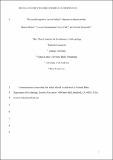Files in this item
The social-cognitive basis of infants’ reference to absent entities
Item metadata
| dc.contributor.author | Bohn, Manuel | |
| dc.contributor.author | Zimmermann, Luise | |
| dc.contributor.author | Call, Josep | |
| dc.contributor.author | Tomasello, Michael | |
| dc.date.accessioned | 2019-04-05T23:38:34Z | |
| dc.date.available | 2019-04-05T23:38:34Z | |
| dc.date.issued | 2018-08 | |
| dc.identifier | 252771205 | |
| dc.identifier | e2d55010-fd6f-4fb6-845d-cea055c7dbd1 | |
| dc.identifier | 85045003169 | |
| dc.identifier | 000435061800006 | |
| dc.identifier.citation | Bohn , M , Zimmermann , L , Call , J & Tomasello , M 2018 , ' The social-cognitive basis of infants’ reference to absent entities ' , Cognition , vol. 177 , pp. 41-48 . https://doi.org/10.1016/j.cognition.2018.03.024 | en |
| dc.identifier.issn | 0010-0277 | |
| dc.identifier.other | RIS: urn:A81B0FCAA15D1779C4BF9583F92D73D9 | |
| dc.identifier.other | ORCID: /0000-0002-8597-8336/work/43646815 | |
| dc.identifier.uri | https://hdl.handle.net/10023/17470 | |
| dc.description | Manuel Bohn was supported by a scholarship of the German National Academic Foundation and Josep Call was supported by the “SOMICS” ERC-Synergy grant (nr. 609819). | en |
| dc.description.abstract | Recent evidence suggests that infants as young as 12 month of age use pointing to communicate about absent entities. The tacit assumption underlying these studies is that infants do so based on tracking what their interlocutor experienced in a previous shared interaction. The present study addresses this assumption empirically. In three experiments, 12-month-old infants could request additional desired objects by pointing to the location in which these objects were previously located. We systematically varied whether the adult from whom infants were requesting had previously experienced the former content of the location with the infant. Infants systematically adjusted their pointing to the now empty location to what they experienced with the adult previously. These results suggest that infants’ ability to communicate about absent referents is based on an incipient form of common ground. | |
| dc.format.extent | 8 | |
| dc.format.extent | 1104191 | |
| dc.language.iso | eng | |
| dc.relation.ispartof | Cognition | en |
| dc.subject | Communication | en |
| dc.subject | Displacement | en |
| dc.subject | Common ground | en |
| dc.subject | Pointing | en |
| dc.subject | Social cognition | en |
| dc.subject | BF Psychology | en |
| dc.subject | DAS | en |
| dc.subject.lcc | BF | en |
| dc.title | The social-cognitive basis of infants’ reference to absent entities | en |
| dc.type | Journal article | en |
| dc.contributor.sponsor | European Research Council | en |
| dc.contributor.institution | University of St Andrews. School of Psychology and Neuroscience | en |
| dc.contributor.institution | University of St Andrews. Centre for Social Learning & Cognitive Evolution | en |
| dc.identifier.doi | https://doi.org/10.1016/j.cognition.2018.03.024 | |
| dc.description.status | Peer reviewed | en |
| dc.date.embargoedUntil | 2019-04-06 | |
| dc.identifier.grantnumber | 609819 | en |
This item appears in the following Collection(s)
Items in the St Andrews Research Repository are protected by copyright, with all rights reserved, unless otherwise indicated.

